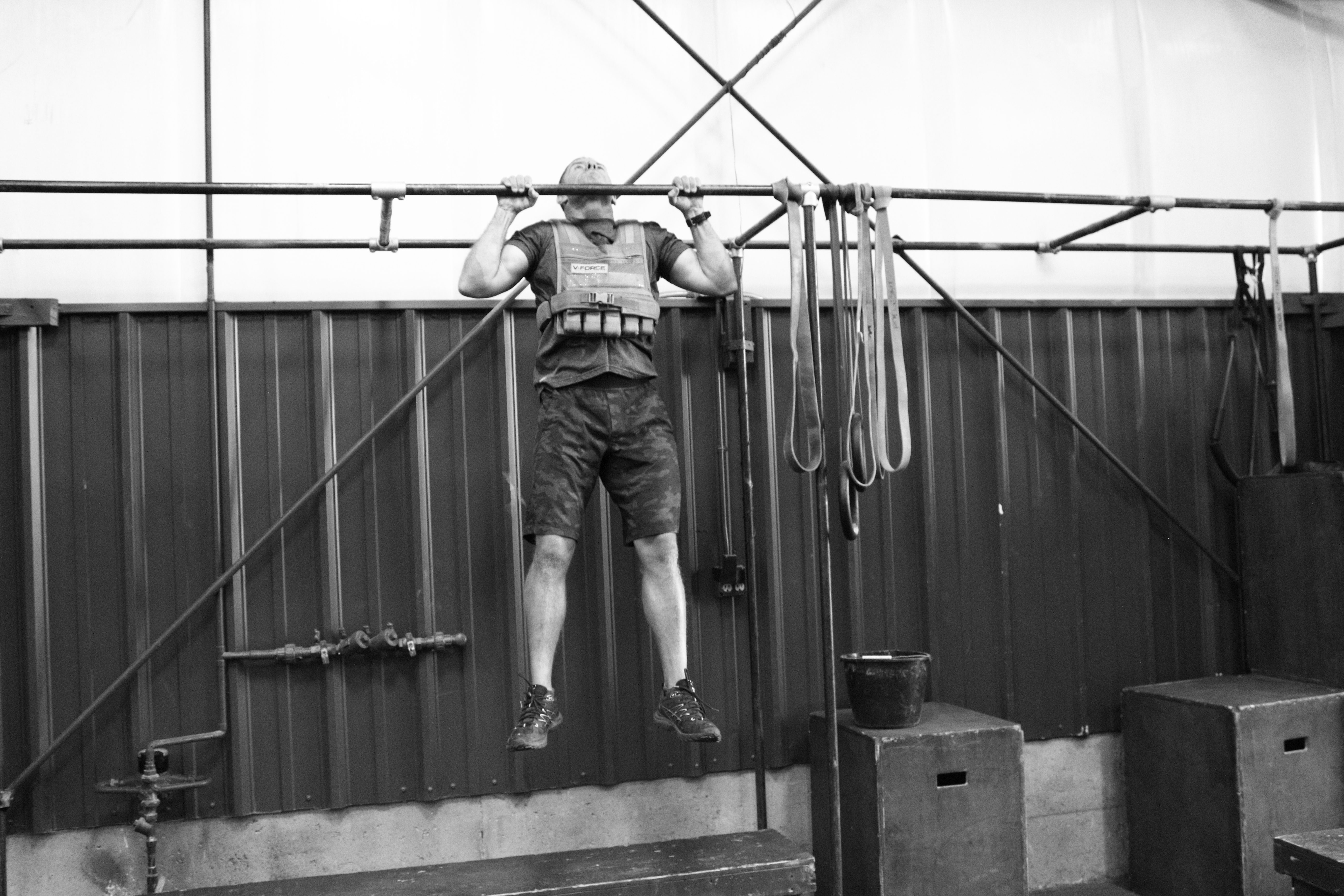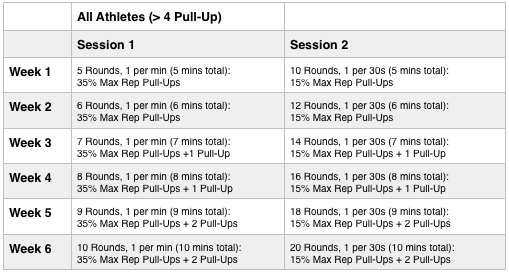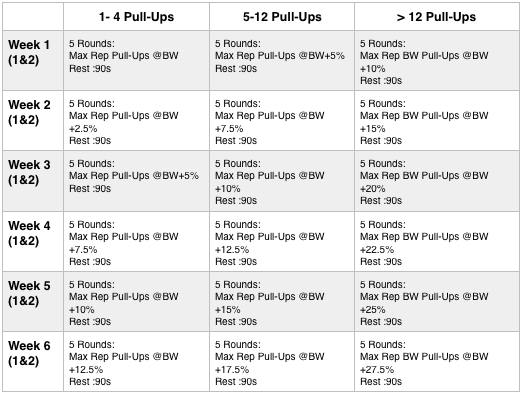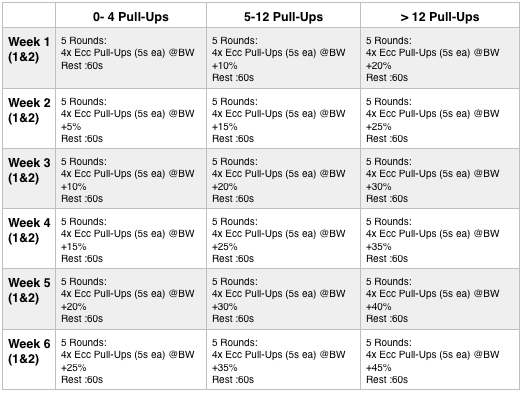
By Adam Scott, MS, CSCS
Increasing max rep bodyweight pull ups, for whatever reason, can be a strength and conditioning conundrum. What works for one athlete, often doesn’t work for another. What works for men, often doesn’t work for women.
Many fitness “experts” offer their own recipe for pull up improvement, but we could not find a study which systematically tested and compared different pull up programming methodologies – so we decided to do our own Mini-Study.
We assessed max rep pull ups with all of our athletes.
We divided our athletes into three groups, and then deployed three distinctly different pull-up training methodologies, one for each group.
We prgressed these different methodologies over six weeks, then re-assessed our athlete’s max rep bodyweight pull up performance, and identified the most effective program.
Our General Approach
- Sport Specific: All training programs will consist solely of pull-ups. While some pull up programs prescribe various modified versions of the pull-up (band assisted, horizontal rows, etc.) or weighted alternatives (lat pull-downs, barbell rows, dumbbell curls, etc.) we found little to no scientific evidence to support these exercise help increase pull-up performance. Each of our methodologies uses pull ups to increase pull up numbers.
- Length: All three programs consisted of six weeks of training divided into two weekly sessions (12 total training sessions)
- Progression: All athletes spent one week (2x training sessions) at each progression for a total of six steps over six weeks.
- Assessments: Athletes were assessed one week prior to beginning the six week training cycle and reassessed the Monday immediately following the completion of the cycle.
- Athlete Training Division: Our athletes’ initial performances’ varied from 0 to 34 pull-ups so we knew we had to address a large range of athletes abilities and needs. I will address our divisions in further detail below, but the basic training groups are: (1) 0-4 Pull-Ups, (2) 5-12 Pull-Ups and (3) Over 12 Pull-Ups.
Three Methodologies
1. Volume Training: With our volume based training our goal was to progressively increase the total number of pull-ups an athlete performs over a given time period. This cycle started at approximately 150% of max reps in five minutes and progressed to over 450% of max reps in ten minutes during the final week. To do this we are used two protocols: (1) 60 second intervals and (2) 30 second intervals. In the past we have seen volume training be effective with athletes who scored in the midranges (4-12) during their pull-up assessment. We were interested to see if this would have any effect on our higher performers (over 20). Because this methodology is difficult to scale for athletes who scored below 4 pull-ups did not use it for our lower scoring athletes.

2. Loaded Training: With our loaded training we chose to follow a very simple progression model – our athletes completed 5 rounds of maximum repetitions with :90s rest between rounds. Athletes progressed by adding either 2.5% or 5.0% of their body-weight each week in external load. However, to determine the athlete’s starting load and progression we had to do a little digging. Since most loading methodologies are based on a 1RM and we did not do a 1RM weighted pull ups assessment we had to estimate our athlete’s 1RM based on their max bodyweight rep score. While there are a number of academic equations available which predict 1RM based on repetitions none of these options are valid over 10-12 repetitions. This meant that for our athletes who can perform over 12 pull ups we had no valid way to estimate their 1RM. After a little experimenting with our lab rats and digging into the academic literature we settled on a way of estimating 1RMs and dividing our athletes into groups which kept them closely aligned based on their estimated 1RMs. Our first group of athletes (0-4 max reps) started their progression with no external loading and progressed to 12.5% of their bodyweight in external loading.
Our second group of athletes (5-12 reps) began heir training with an external load of 5% of their bodyweight, and progressed to 17.5%.
Our final group of athletes (>12 reps) started with 10% of their bodyweight in external loading and progressed to 27.5%.

3. Eccentric Training: We initially selected eccentric training as a primary tool for our lower scoring athletes (0-4 pull ups). Our thought was that eccentric training would allow our athletes to work through the full range of motion and train specifically for the movement, just in reverse. Thus, they would not be overly limited by their initial performance.
However, as we started to research and experiment with the programming we began to wonder if eccentric training could also be a valid way to help athletes at the middle and higher ranges of max pull up reps.
Most eccentric training research is focused on leg dominate movements and upper body pushing. Studies have shown eccentric training extremely effective for hypertrophy and, since athletes are typically 20-30% stronger eccentrically, strength training.
With this in mind, we decided to put some of our higher scoring athletes into this training group and see what would happen. Since, like loaded training, eccentric training is typically based on a 1RM we were able to use the same calculations and groups we used for the loaded group, but with the added benefit of an additional 20-30% of strength gained through training eccentrically
All athletes in the eccentric training group progressed by adding 5% of their bodyweight in external loading each week. The only difference was the starting point:
– 0-4 Rep Group: no external loading for week 1
– 5-12 Rep Group: 10% of body-weight in external loading
– >12 Rep Group: 20% of body-weight in external loading

Further, we really worked to control the total volume for this group, limiting each session to 5 sets of 4 eccentric reps. As well, each eccentric rep will last 5 seconds. In practice, the athletes jumped up to get their chin above the bar, then lowered themselves down to full extension slowly, on a 5 second count.
To Read The Results and Discussion of this Mini-Study Click Here
You Might Also Like MTI’s 3-Week Push-Up & Pull Up Improvement Training Plan
